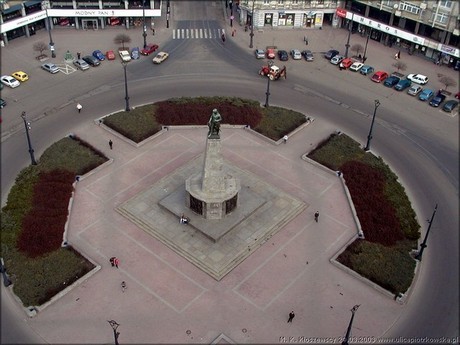Liberty Square
At the square in 1827 stood Town Hall, and the Evangelical church St. Trinity (the first representative buildings of Lodz). In 1898 to the square reached new trams, and the marketplace has been transformed into a representative square.
The market was renamed Freedom Square at the time of regaining independence in 1918. In 1930, the center of the square, stood the statue of Tadeusz Kosciuszko. After annexation by Nazi Lodz German occupation authorities demolished the statue of Lodz, 11 November 1939, and renamed the square to Children's Freiheitsplatz, and in 1940 the Deutschlandplatz
Several hundred metres south of the Old Town a new settlement grew in the 1820s. It opened up the straight-line course of Piotrkowski Trakt, its making was the beginning of the industrial development of the city. The square in the middle of the settlement functioned as a market place. It can be still seen in the post-cards from the beginning of the century. The architecture of the oldest part of the frontage had an interesting look, too. On both sides of ul. Piotrkowska two buildings were raised in 1826-1828, close to each other in terms of their Classicist form - the town hall and the Evangelical church of the Holy Trinity, designed by Bonifacy Witkowski, architect of the Mazovian Voivodship Committee. From the east the square has got a small, rectangular annex with an arcade. This is a remainder of the Old Town butcher's stalls, ace. to the design by H. Marconi from the first half of the 19th c.
The church, the main dominante of the square, acquired its present-day form in the years 1889-1896. (des. O. Gehlig). Today the temple, under the invocation of the Holy Trinity, is used by the Roman Catholics. Attention ought to be paid to the monumental building of the Archeological and Ethnograpic Museum, housed in the former municipal offices. It acquired its present-day form in the course of the thorough transformations introduced in the years 1924-26 by the architect W. Lisowski. Originally, there was the oldest Lodz school that stood in this place, founded in 1856) - still another evidence of the former importance of Nowy Rynek.
On the other hand, the oldest, uniform residential architecture of the most distinct city square has disappeared altogether. It was demolished after the last war and partly replaced with the houses designed by R. Millo. Only two tenements from the turn of the 20th c have remained. One of them is decorated with the statue of the lion - the king of the numerous enough 'Lodz jungle', there being suprisingly many representations of animals upon the city facades.There is also an insignificant tenement, converted from a still older house -the seat of the oldest Lodz chemist's, owned by Ketschman. Finally, there is the well, decorated with dolphins, cabs (droshkys) used to wait for their passengers at not so long ago. The central part of the square is marked by a high obelisk, resembling a chimney, but functioning as the pedestal for the statue of Commander Tadeusz Kosciuszko. Plac Wolnosci is the local transport junction, but also a perfect landmark and the starting point for many a tourist sightseeing route.



